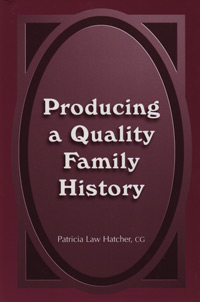 What does it take to put together a family history worth reading? The short answer is time, money, and effort. However, after all the work you have done in researching, collecting documents, gathering pictures, sorting, and recording genealogies and family stories, putting a family history together should seem like a piece of cake. To help researchers preserve their family histories and make the process as streamlined as possible, Patricia Law Hatcher has written the helpful guide, Producing a Quality Family History. Note the the special offer on book of 10% off at the FRPC website is extended through midnight EDT Monday, March 16, 2015.
What does it take to put together a family history worth reading? The short answer is time, money, and effort. However, after all the work you have done in researching, collecting documents, gathering pictures, sorting, and recording genealogies and family stories, putting a family history together should seem like a piece of cake. To help researchers preserve their family histories and make the process as streamlined as possible, Patricia Law Hatcher has written the helpful guide, Producing a Quality Family History. Note the the special offer on book of 10% off at the FRPC website is extended through midnight EDT Monday, March 16, 2015.
The obvious follow-up question is, what makes a “quality” family history? As a publisher and book designer, I have developed my own ideas over the years as to what makes a quality book. I have also learned that others have their own idea of what quality means. Hatcher acknowledges personal preferences in choosing how to produce a family history. She recommends researchers start by reviewing family histories at a library. She, also, goes on to suggest there are some basic guideline, or qualities, which should be followed. The list reads as follows (referring to a quality work):
It presents quality research–research that is thorough, new, and based on a variety of primary sources
- It is well organized, understandable, and attractively presented
- It uses a recognized genealogical numbering system
- It documents each fact and relationship fully
- It expresses information accurately, indicating the likelihood of conclusions
- It goes beyond records, placing people in context
- It included illustrations such as maps, charts, and photographs
- It has a thoughtful and thorough index
Producing a Quality Family History can help the reader create a manuscript, and final publishing, to meet and exceed these criteria. Not only is content reviewed, but layout and design, font selection, editing, and developing a print ready history are all covered. This book is meant to help you avoid mistakes before you even start writing. However, even if you are almost ready to print your book, this guide can help you feel confident you have produced a quality history, before you go to print.
Patricia Hatcher is a technical writer, instructor and certified genealogists. Having written and edited numerous books and articles, she is well versed in the subject. This guide is easy to follow, and equally easy to implement in your own writing. As Hatcher notes in the book, nonfiction writing is to inform, but that doesn’t mean it can’t be, or even shouldn’t be, interesting. Genealogies reproduce facts, family histories, when properly written, give life to your ancestors. Through this guide, your family history can find the life and quality you always dreamed about.
Contents
Publishing Family History in the 1990s
What to Write; When to Write It
You Must Have Style
Writing
Understanding Type and Fonts
Book Design
Page Layout and Formatting
Organizing and Presenting Family Information
How Do You Know?
Turning Paper into People
Illustrations, Charts, and Photographs
Opening the Door to Your Book
Developing an Editorial Eye
Preparing Camera-Ready Art
Turning Camera-Ready Art into Books
Options from Technology
Self-Publishing
Resources
Index
Producing a Quality Family History is available from Family Roots Publishing in a beautiful hardback edition – 10% off extended throughthrough Monday, March 16, 2015. Click on the link for more information.